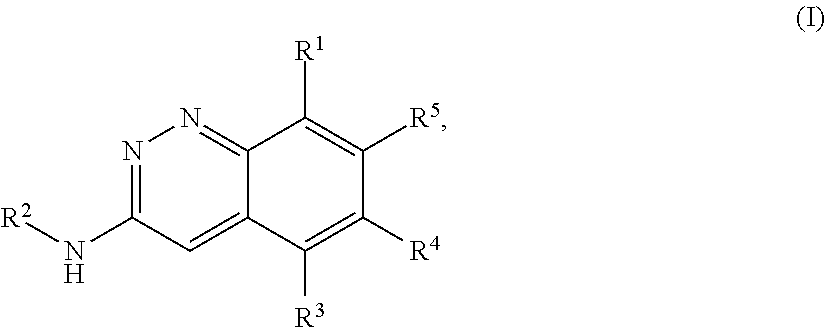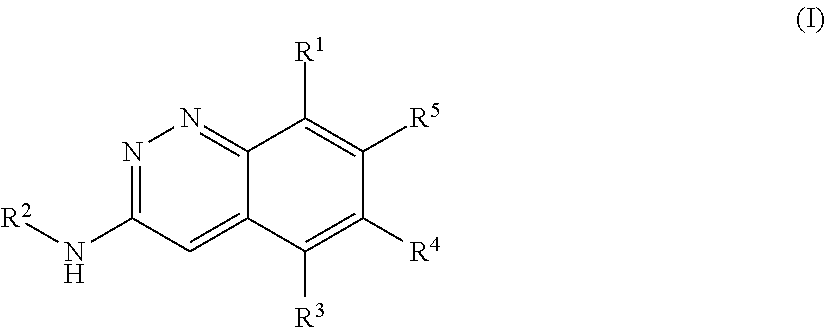Cinnoline compounds and uses thereof
a technology of compound and cinnaline, which is applied in the field of compound, can solve the problems of damaging healthy cells, not being able to successfully resection, and many tumors or cancer forms,
- Summary
- Abstract
- Description
- Claims
- Application Information
AI Technical Summary
Benefits of technology
Problems solved by technology
Method used
Image
Examples
examples
Abbreviations
[0344]aq. aqueous[0345]n-BuLi n-butyllithium solution[0346]DCE 1,2-dichloroethane[0347]DCM dichloromethane[0348]DIBAL diisobutylaluminum hydride[0349]DIPEA diisopropylethylamine[0350]DMA dimethylacetamide[0351]DME 1,2-dimethoxyethane[0352]DMF N,N-dimethylformamide[0353]DMSO dimethylsulfoxide[0354]DMSO-d6 deuterated dimethylsulfoxide[0355]EDCI.HCl N-(3-dimethylaminopropyl)-N′-ethylcarbodiimide hydrochloride[0356]ESI electrospray ionization[0357]EtOAc ethyl acetate[0358]Et2O diethyl ether[0359]h hours[0360]HATU O-(7-azabenzotriazol-1-yl)-N,N,N′,N′-tetramethyluronium hexafluorophosphate[0361]HCl hydrochloric acid[0362]HOBT 1-hydroxybenzotriazole[0363]IMS industrial methylated spirits[0364]LCMS liquid chromatography-mass spectrometry[0365]NaOH sodium hydroxide[0366]NMR nuclear magnetic resonance[0367]MeCN acetonitrile[0368]MeOH methanol[0369]MeOH.NH3 2N methanolic ammonia[0370]mg milligram[0371]mmol millimole[0372]MgSO4 magnesium sulfate[0373]min minutes[0374]mL millilitre[...
example i-1
Intermediate 1: 6-bromo-8-chlorocinnolin-3-amine
[0400]
Step 1: (4-Bromo-2-chlorophenyl)hydrazine
[0401]
[0402]To a mixture of 4-bromo-2-chloroaniline (5 g, 24 mmol) in conc. hydrochloric acid (9 mL) was added NaNO2 (1.8 g, 26 mmol) in water (8 mL) dropwise at 0° C. The mixture was stirred at 0° C. for 1 h. To the reaction mixture was added SnCl2 (9 g, 48 mmol) in conc. hydrochloric acid (16 mL). The mixture was stirred at RT overnight. The reaction was then cooled to 0° C. and 40% NaOH solution was added to adjust the mixture to a pH=8. The mixture was extracted with EtOAc (500 mL×2). The organic layer was washed with brine (200 mL), dried over Na2SO4, filtered and concentrated. Ether (100 mL) and 5 drops of MeOH were added. The resulting slurry was filtered to afford the desired (4-bromo-2-chloro-phenyl)hydrazine (4.8 g, 49% yield) as a yellow solid. LCMS (ESI) [M+H]+=221.1.
Step 2: N′-(4-Bromo-2-chlorophenyl)-2,2-diethoxyacetimidohydrazide
[0403]
[0404]To a solution of methyl 2,2-dietho...
example 1
(1S,2S)—N-(8-Amino-6-(1-ethyl-1H-pyrazol-4-yl)cinnolin-3-yl)-2-fluorocyclopropane carboxamide (Compound 1a)
[0407]
Step 1: 8-Chloro-6-(1-ethyl-1H-pyrazol-4-yl)cinnolin-3-amine
[0408]
[0409]1-ethyl-1H-pyrazole-4-boronic acid (86 mg, 0.39 mmol), Pd(dppf)Cl2 (28 mg, 0.04 mmol) and K2CO3 (160 mg, 1.2 mmol) were added sequentially to a solution 6-bromo-8-chloro-cinnolin-3-amine (200 mg, 0.39 mmol) in 1,4-dioxane (15 mL) and water (2 mL). The reaction mixture was stirred at 100° C. overnight and then filtered. The filtrate was partitioned between H2O (10 mL) and CH2C2(2×10 mL). The combined organic layers were dried over Na2SO4, filtered and concentrated. The residue was purified by reverse phase (C-18) column chromatography (A:Water(10 mM NH4HCO3) B:ACN) to afford 8-chloro-6-(1-ethylpyrazol-4-yl)cinnolin-3-amine (50 mg, 47% yield) as a yellow solid. LCMS (ESI) [M+H]+=365.1.
Step 2: (1S,2S)—N-(8-chloro-6-(1-ethyl-1H-pyrazol-4-yl)cinnolin-3-yl)-2-fluorocyclopropane carboxamide
[0410]
[0411]A flas...
PUM
| Property | Measurement | Unit |
|---|---|---|
| Rg | aaaaa | aaaaa |
| temperature | aaaaa | aaaaa |
| pH | aaaaa | aaaaa |
Abstract
Description
Claims
Application Information
 Login to View More
Login to View More - R&D
- Intellectual Property
- Life Sciences
- Materials
- Tech Scout
- Unparalleled Data Quality
- Higher Quality Content
- 60% Fewer Hallucinations
Browse by: Latest US Patents, China's latest patents, Technical Efficacy Thesaurus, Application Domain, Technology Topic, Popular Technical Reports.
© 2025 PatSnap. All rights reserved.Legal|Privacy policy|Modern Slavery Act Transparency Statement|Sitemap|About US| Contact US: help@patsnap.com



